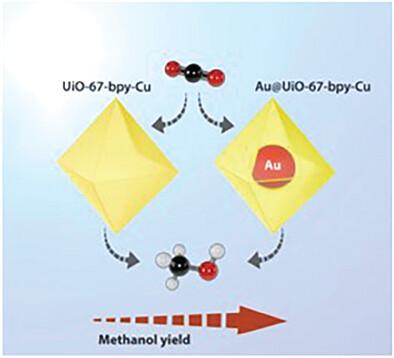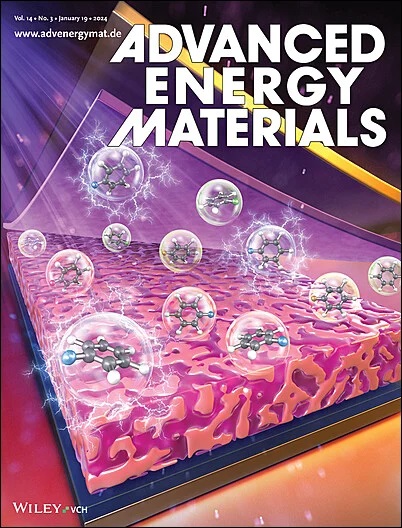Bifunctional Au@UiO-67-bpy-Cu Plasmonic Nanostructures for the Solar-Driven CO2 Reduction to Methanol
IF 24.4
1区 材料科学
Q1 CHEMISTRY, PHYSICAL
引用次数: 0
Abstract
Photocatalytic CO2 reduction is gaining more interest as a sustainable route to produce methanol, a key starting material in the synthesis of many chemicals and a potential energy carrier. Here, metal-organic frameworks (MOFs) are used as platforms to integrate plasmonic Au nanospheres and Cu active centers in joint bifunctional hybrid photocatalysts. The methodology followed in obtaining stable Au@UiO-67-bpy-Cu MOFs is based on synthesizing Au@UiO-67-bypiridine (bpy) MOFs through a core-shell procedure, and then modifying them with Cu ions after their coordination with the bpy ligands. This gains the final structure regular coverage of active metal centers that can be excited by the interaction with the plasmonic nanospheres. In the absence of Au, the system demonstrates selectivity toward the formation of methanol under hole scavenger-free conditions owing to the excitation of the bpy-Cu complex with visible light. The obtained yield duplicates upon Au nanospheres incorporation as a result of the injection of hot electrons, excited by surface-mediated intraband processes, to the bpy-Cu states, thus increasing their CO2 reduction efficiency. Additionally, the catalytic activity remains stable during four consecutive cycles.

用于太阳能驱动的二氧化碳还原成甲醇的双功能 Au@UiO-67-bpy-Cu 质子纳米结构
光催化二氧化碳还原作为一种生产甲醇的可持续途径,正受到越来越多的关注。甲醇是合成多种化学品的关键起始材料,也是一种潜在的能源载体。本文以金属有机框架(MOFs)为平台,将等离子体金纳米球和铜活性中心整合到双功能混合光催化剂中。获得稳定的 Au@UiO-67-bpy-Cu MOFs 的方法是通过核壳程序合成 Au@UiO-67-bypiridine (bpy) MOFs,然后在与 bpy 配体配位后用 Cu 离子对其进行修饰。这样就获得了最终结构中活性金属中心的规则覆盖,这些金属中心可通过与等离子纳米球的相互作用而被激发。在没有金的情况下,由于可见光激发了 bpy-Cu 复合物,该系统在无空穴清除剂的条件下显示出生成甲醇的选择性。加入金纳米球后,由于表面介导的带内过程激发的热电子注入到 bpy-Cu 态,从而提高了二氧化碳的还原效率,因此获得的产率也随之增加。此外,催化活性在连续四个周期内保持稳定。
本文章由计算机程序翻译,如有差异,请以英文原文为准。
求助全文
约1分钟内获得全文
求助全文
来源期刊

Advanced Energy Materials
CHEMISTRY, PHYSICAL-ENERGY & FUELS
CiteScore
41.90
自引率
4.00%
发文量
889
审稿时长
1.4 months
期刊介绍:
Established in 2011, Advanced Energy Materials is an international, interdisciplinary, English-language journal that focuses on materials used in energy harvesting, conversion, and storage. It is regarded as a top-quality journal alongside Advanced Materials, Advanced Functional Materials, and Small.
With a 2022 Impact Factor of 27.8, Advanced Energy Materials is considered a prime source for the best energy-related research. The journal covers a wide range of topics in energy-related research, including organic and inorganic photovoltaics, batteries and supercapacitors, fuel cells, hydrogen generation and storage, thermoelectrics, water splitting and photocatalysis, solar fuels and thermosolar power, magnetocalorics, and piezoelectronics.
The readership of Advanced Energy Materials includes materials scientists, chemists, physicists, and engineers in both academia and industry. The journal is indexed in various databases and collections, such as Advanced Technologies & Aerospace Database, FIZ Karlsruhe, INSPEC (IET), Science Citation Index Expanded, Technology Collection, and Web of Science, among others.
文献相关原料
| 公司名称 | 产品信息 | 采购帮参考价格 |
|---|
 求助内容:
求助内容: 应助结果提醒方式:
应助结果提醒方式:


